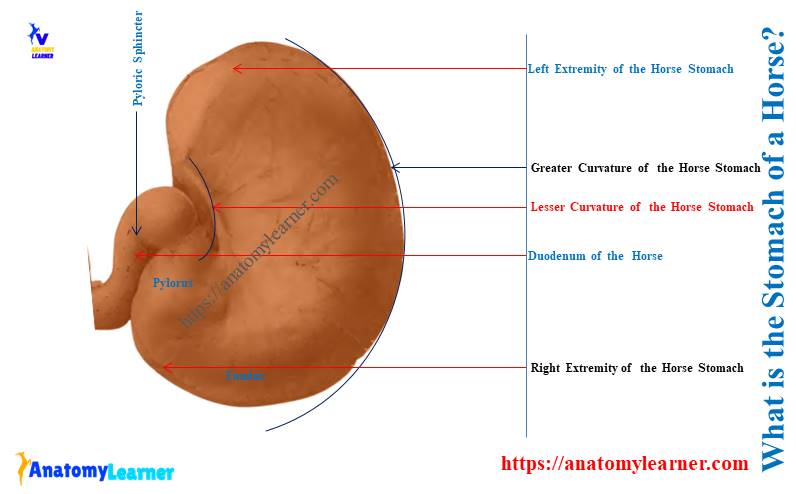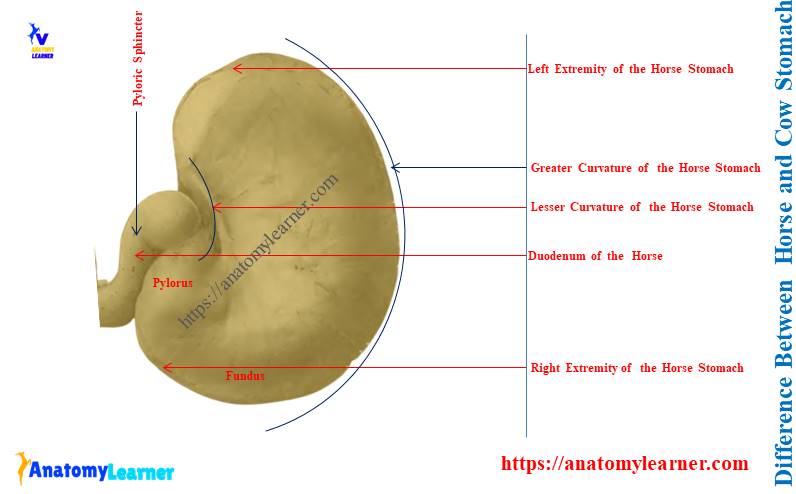You will find a significant variation in the structure between a horse’s and a cow’s stomach. Let’s explore the answer to the question – what is the difference between a horse and a cow stomach?
Quick answer: a horse possess a simple stomach, whereas a cow has a compound stomach. There are four different compartments in the cow’s stomach. In contrast, the horse has two parts in its stomach, separated by margoplicatus.
This article might help you to differentiate horse stomachs from cows with their typical features. I will describe the important anatomical features of the stomach of these two species.
Then I will provide the main identifying features between a horse and a cow’s stomach with a diagram. So, if you want to learn the variation between horse and cow stomachs, let’s continue this article.
What is the difference between a horse and a cow stomach?
The horse stomach is the large dilatation of the alimentary canal. You will find the stomach between the esophagus and the small intestine.
The stomach of a horse is comparatively small than a cow’s. It locates in the dorsal part of the abdominal cavity behind the diaphragm and liver.
The cow’s stomach is comparatively larger and occupies three-fourths of the abdomen. Again, the anatomy of the cow stomach is somewhat different than these of the horse stomach.

Let’s see the main differences between a horse and a cow stomach from Table 1 –
| Features | Horse stomach | Cow stomach |
| Type of stomach | Simple stomach | Compound stomach |
| Size | Smaller | Larger and capacious |
| Shape | J –shaped | Compound sac-like |
| Extension | Dorsal part of abdomen | 7th ribs to pelvic inlet |
| Opening of esophagus | Cul-de-sac (saccus cecus) | Atrium ventriculi |
| Compartments | 2 parts – Glandular and Non-glandular | 4 compartments – Rumen, Reticulum, Omasum, and Abomasum |
| Margoplicatus | Between glandular and non-glandular parts | Internal structure shows various appearances – Rumen – carpet like Reticulum – honeycomb, Omasum – lamine, and Abdomasum – thick folds, |
| Glandular part | Divided into 3 – Cardiac, Fundus, and Pyloric | Abomasum is glandular part Divides into 3 parts – Cardiac, fundus, and pyloric |
| Pyloric end | Comparatively small | Larger |
So, the primary key differences between a horse and a cow stomach are –
- Horses have simple stomachs, where the cow possess compound stomachs,
- The stomach is J-shaped in a horse, whereas the cow has a compound sac-like stomach,
- The horse stomach shows 2 parts, and the cow stomach possesses identifiable 4 different compartments,
The internal features of 4 compartments of the cow stomach are unique. And you will only find a unique margoplicatus in the horse’s stomach. This is a rough line that separates the glandular part from the non-glandular parts.
What is the stomach of a horse?
The stomach is the larger dilatation of the digestive tract in a horse. It is a sharply curved, J-shaped sac-like structure between the esophagus and intestine.
Some authors also express the shape of the horse’s stomach as U-shape. The right part of the horse’s stomach is much shorter than the left part.
It is relatively small, and lies left of the median plane of the body (within the abdominal cavity).
You may or may not identify the right and left sacs of the horse’s stomach in normal condition. But in slightly distended conditions, you may identify the right and left sacs from a horse stomach.
Let’s try to identify the below-mentioned anatomical features from the horse’s stomach –
- Parietal and visceral surfaces of the horse stomach,
- The lesser and greater curvature of the equine stomach,
- Left and right extremities of the horse’s stomach,
- Saccus caecus of the stomach,
- Cardiac, fundus, and pyloric parts from the right or pyloric extremity,
- The pyloric sphincter between the last part of the pylorus and the first part of the small intestine,
Here, the horse stomach labeled diagram shows the above-mentioned anatomical features. Again, you will find some peritoneal folds that connect the various parts with surrounding organs.
I will discuss these peritoneal folds in the next section of this article. You may also get the full idea of the horse stomach from the below-mentioned article –
Horse stomach description
You already found 2 surfaces, 2 curvatures, and 2 extremities that I have identified in the previous diagram. The parietal surface is convex and directed forward, upward, and toward the left.
This parietal surface of the horse’s stomach lies against the diaphragm and liver. Again, the visceral surface is also convex and related to the colon, pancreas, intestine, and omentum.
Now, the greater and lesser curvatures are easily identifiable from the horse’s stomach. Ensure you understand how these curvatures form in the horse’s stomach.
The visceral and parietal surfaces join and form these lesser and greater curvatures in the stomach. Here, the lesser curvature is very short, whereas the greater curvature is extensive.
The lesser curvature extends from the end part of the esophagus to the first part of the small intestine. Again, the greater curvature curves dorsally and cover most of the part of the stomach. Finally, it curves upward to the end of the pylorus.
You will find the cul-de-sac or saccus caecus in the left extremity of the horse’s stomach. And you know, this is the area where the end of the esophagus opens.
Here, the right or pyloric part of the stomach is small that continues with the small intestine. I have identified 3 parts (cardiac, fundus, and pylorus) from this part. You will also find a well-developed pyloric sphincter at the end of this pyloric extremity.
How is the horse’s stomach held in position?
The horse’s stomach is held in its position by the surrounding organs, peritoneal folds, and the esophagus. You will find various peritoneal folds like gastro phrenic, lesser omentum, gastrosplenic, and others in the stomach structure.
Let’s see these folds with their attachment to the various parts of the horse’s stomach –
- Gastro phrenic ligament – connects the greater curvature of the horse’s stomach to the crura of the diaphragm,
- Lesser omentum – connect lesser omentum and duodenum with the liver,
- Gastro splenic ligament – connects greater curvature with the hilus of the spleen,
- Greater omentum – connect the ventral part of the greater curvature and duodenum with the end part of the larger colon, and
- Gastro pancreatic ligament – connects the left sac of the stomach with the liver, vena cava, and pancreas,
What kind of stomach does a cow have?
A cow has a compound stomach, which is very capacious compared to a horse. It almost fills the left half of the abdominal cavity of the cow.
The capacity of the cow’s stomach varies with the age and breed. A medium-sized cow has a 30 – 40 gallons capacity in its stomach.
You will find 2 surfaces, 2 curvatures, and 2 extremities in the anatomy of a cow stomach. The parietal surface of the cow stomach (left) is convex. This surface is related to the left abdominal wall, diaphragm, and spleen.
The right or visceral surface is also convex and related to the various internal organs. You will find right and left longitudinal grooves in the structure of a cow’s stomach.
Both the dorsal and ventral curvatures of the cow stomach are convex. Here, the dorsal curvature of a cow’s stomach is related to the crura of the diaphragm and sublumbar muscles. Where the ventral curvature of the cow stomach is related to the floor of the abdominal cavity.
The cranial end is related to the diaphragm and divides into two blind sacs by groove. At the same time, the caudal end is related to the intestine and bladder and divides into two blind sacs by a transverse groove.
All the external features from the cow stomach anatomy are identified in the below-mentioned diagram –
You may also know the full features of a cow or ruminant stomach from this article –
How many parts does a cow’s stomach have?
The cow’s stomach has 4 parts or compartments – rumen, reticulum, omasum, and abomasum. Here, the rumen is the larger compartment and occupies almost all of the left half of the abdomen.
It is comparessed side by side and possesses 2 surfaces, 2 borders, and 2 extremities. I have already described all the surfaces, borders, and extremities from the rumen in the previously mentioned article.
The rumen of the cow has 4 sacs – dorsal, ventral, caudo-dorsal blind, and caudo-ventral blind sacs. How these sacs are formed in the rumen is described previously.
The reticulum compartment of the cow’s stomach is the most cranial part. It lies against the diaphragm and liver.
It is almost pyriform in shape and consists of 2 surfaces, 2 curvatures, and 2 extremities. The internal appearance of the reticulum is essential for differentiating it from the other 3 compartments. You will see the internal honeycomb appearance, which is unique in the reticulum.
The omasum of the cow stomach is ellipsoidal and compressed from side to side. You will find 2 surfaces, 2 curvatures, and a neck in the structure of the cow’s omasum. The internal surface of the cow’s omasum shows omasal laminae.
Finally, the last part of the cow’s stomach is the abomasum. It is an elongated and piriform sac-like structure in the cow’s stomach.
It mostly lies on the abdominal floor and possesses 3 parts – cardiac, fundus, and pyloric. The structure of the cow’s abomasum is similar to the glandular part of the horse’s stomach.
Know more about the various organs of a cow’s digestive system from the below-mentioned article –
Conclusion
So, you got the answer to your question – what is the difference between a horse and a cow stomach? The shape, external appearance, type, and number of compartments are the major differentiating features between a horse’s and a cow’s stomach.
Again, the presence of margoplicatus in the horse’s stomach is unique. The enlarged pyloric end differentiates between a horse’s and a cow’s stomach.

